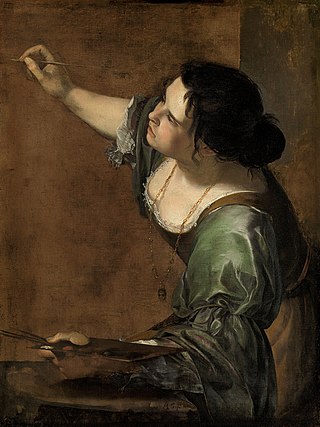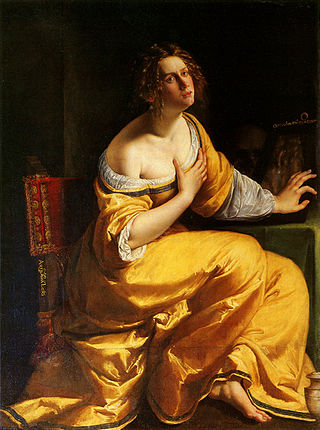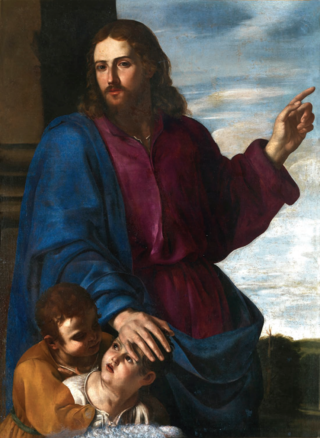
Artemisia Lomi or Artemisia Gentileschi was an Italian Baroque painter. Gentileschi is considered among the most accomplished seventeenth-century artists, initially working in the style of Caravaggio. She was producing professional work by the age of 15. In an era when women had few opportunities to pursue artistic training or work as professional artists, Gentileschi was the first woman to become a member of the Accademia di Arte del Disegno in Florence and she had an international clientele.

Orazio Lomi Gentileschi (1563–1639) was an Italian painter. Born in Tuscany, he began his career in Rome, painting in a Mannerist style, much of his work consisting of painting the figures within the decorative schemes of other artists.

The Galleria Spada is a museum in Rome, which is housed in the Palazzo Spada on Piazza Capo di Ferro. The palazzo is also famous for its façade and for the forced perspective gallery by Francesco Borromini.

Susanna and the Elders is a 1610 painting by the Italian Baroque artist Artemisia Gentileschi and is her earliest-known signed and dated work. It was one of Gentileschi's signature works. She painted several variations of the scene in her career. It currently hangs at Schloss Weißenstein in Pommersfelden, Germany. The work shows an uncomfortable Susanna with two men lurking above her while she is in the bath. The subject matter comes from the deuterocanonical Book of Susanna in the Additions to Daniel. This was a popular scene to paint during the Baroque period.
This is an ongoing bibliography of work related to the Italian baroque painter Artemisia Gentileschi.

Madonna and Child is an early painting by the baroque painter Artemisia Gentileschi. It was painted around 1613, when Artemisia was around 20 years old. It currently hangs in the Galleria Spada in Rome.

Self-Portrait as a Female Martyr, is also known as the Self-Portrait as a Martyr Saint. This painting was created by the Italian female artist, Artemisia Gentileschi. This self-portrait was made around 1615 depicting the artist herself as a martyr. It is one of two paintings by Gentileschi painted with oil on a wood panel. This self-portrait is currently in a private collection in the United States.

Santa Cecilia is an early painting, from c. 1620, by the Baroque painter Artemisia Gentileschi, a painter described as "a grand exception in the history of art - a successful woman painter in an era in which art was dominated by men."

Penitent Magdalene is a 1616–1618 painting by the Italian baroque artist Artemisia Gentileschi. This painting hangs in the Pitti Palace in Florence. The subject is the biblical figure Mary Magdalene, but the painting references another biblical woman, Mary, the sister of Lazarus. This painting was likely painted during Gentileschi's Florentine period.

Corisca and the Satyr was painted in the 1630s by the Italian artist Artemisia Gentileschi. It currently hangs in a private collection.

Susanna and the Elders is a 1652 painting by the Italian artist Artemisia Gentileschi. It currently hangs in the Pinacoteca Nazionale, Bologna. The painting, over two metres broad, was completed in collaboration with Gentileschi's pupil Onofrio Palumbo - documents relating to the sale of the painting mention a payment to Palumbo.

The Self Portrait of Italian baroque artist Artemisia Gentileschi was painted in the early 1630s. It currently hangs in the Palazzo Barberini, Rome. It is one of many paintings where Gentileschi depicts herself. Beyond self-portraits, her allegorical and religious paintings often featured herself in different guises.

Self-Portrait as Saint Catherine of Alexandria is a 1615–1617 painting by the Italian Baroque artist Artemisia Gentileschi, showing the artist in the guise of Catherine of Alexandria. It is now in the collection of the National Gallery, London, which purchased it in 2018 for £3.6 million, including about £2.7 million from its American Friends group.

Annunciation is a 1600-1605 oil on alabaster painting by Orazio Gentileschi, later mounted on slate. Produced in Rome for an unknown private commissioner, it is now in Álvaro Saieh and Ana Guzmán's residence as part of the Alana collection in Newark, Delaware, USA.

Tarquin and Lucretia is a 1620–1650 oil on canvas painting by Artemisia Gentileschi. It hangs in the Great Hall of the Neues Palais in Potsdam. It is one of three paintings that Gentileschi painted of Lucretia, the wife of Roman consul and general Tarquinus, at the moment of her suicide. The other two versions are in a private collection in Milan and The Getty Museum in Los Angeles.

Bathsheba is a 1636-37 painting by the Baroque painter Artemisia Gentileschi, with contributions by Viviano Codazzi and Domenico Gargiulo. It shows the Hittite woman Bathsheba being washed and tended to by her servants. At the top left of the painting, King David sees her from his palace. It was one of seven versions from the story of Bathsheba that Gentileschi painted.

Clio, Muse of History is a painting by the baroque painter Artemisia Gentileschi. It was painted around 1632, just after Artemisia had moved to Naples. It currently hangs in the Palazzo Blu, Pisa. The painting has been interpreted in relationship to Gentileschi's own career and self-image - "by including her signature in Clio's open book, Artemisia was quite literally writing herself into history". In stylistic terms, the painting demonstrates Gentileschi's borrowing from Venetian styles of painting where she "applied her colors in a free and more spontaneous fashion."

Aurora is a c.1625-1627 painting by the Italian artist Artemisia Gentileschi, depicting the Roman goddess of dawn. It is part of a private collection in Rome.

Christ Blessing the Children is a painting by the Italian artist Artemisia Gentileschi, depicting an episode from the New Testament. It hangs in the church of S. Carlo al Corso in Rome.


















